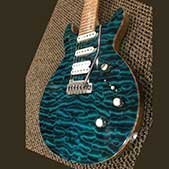Since James has already answered, I thought I'd chip in on how I handled this (hey, it worked!).
Using smaller versions of the pics I posted earlier, there are actually three mixers pictured. In the top left rack (first two units) is an analog mixer Rolls RM 203x) and a digital mixer (Roland M1000). The primary sub-mixer is on top of the rack to the right (a Mackie 1202-VLZ). The stereo outputs from the 1202-VLZ went to two channels on my main mixer (a Mackie CFX-12). My main keyboard synth (a Korg N5) went directly into the CFX-12. The 1202-VLZ had separate channels for both of the rack mixers, my V-Drum set (not pictured, but just off to the right), and the Korg MS2000 at the bottom of the right picture. All other samplers, ROMplers and synths were combined using the rack mixers.
So, why the extra rack mixers? Three reasons. First, I had too many devices for the available channels on the 1202-VLZ, second, I kept the mic channels available for the rare occasion where I had more than one person over that could actually sing and, third, there are no digital inputs on the Mackie so the Roland took care of the A/D conversion.





